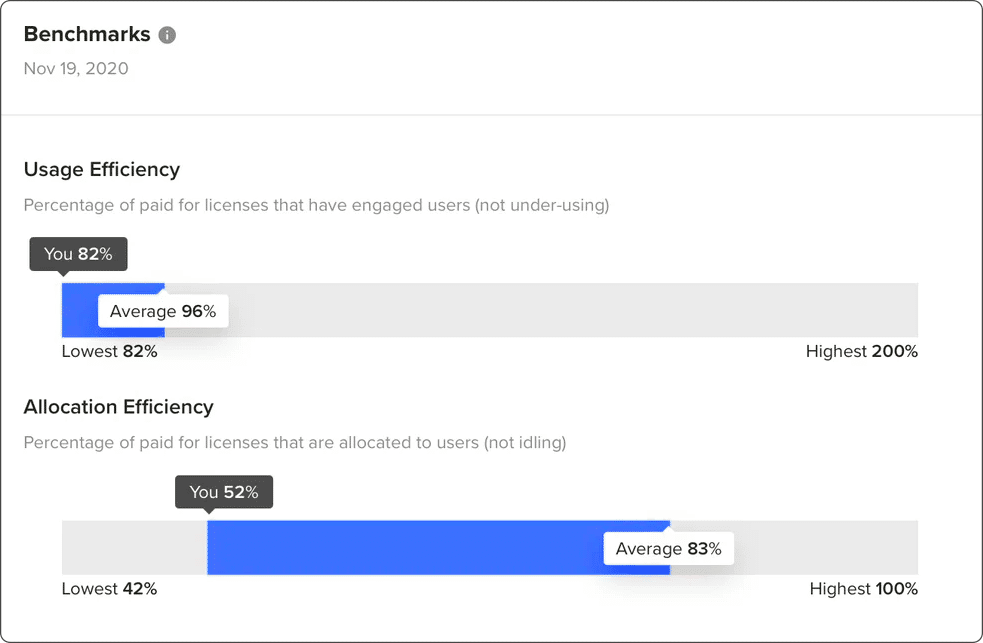Your guide to make software spend optimization work for you

As your business scales, more and more SaaS applications are added to your tech stack, no spreadsheet can keep up with. That’s where a SaaS management platform comes in.
SaaS management platforms need to provide IT professionals visibility into their tech stack, automate permissions and processes, and provide valuable insights into software spending to identify underutilized resources and cost-saving opportunities.
Software spend optimization is the process of managing not only your spend on software, but your contracts, account usage, and compliance.
Adapting a software spend optimization plan is easier said than done, so let’s dive into some common challenges you may face along the way, in addition to best practices that can make it work for your company.
Challenges surrounding software spend optimization
As you move toward a plan of optimizing your company’s software spend, here are some potential roadblocks that your team may experience.
First things first, as you dive into the optimization process you’ll need to take stock of the problems your company is facing, and just how bad each problem is. To do so, you’ll need to analyze the full picture of your organization’s software applications.
This presents many challenges, one being the expansiveness of SaaS, resulting in so many different ways that a software solution can enter your organization’s stack. Whether it’s from central procurement, departmental purchases, or individuals buying their own software and expensing it, your SaaS footprint can grow to be larger than you’re aware of – and fast.
It’s also common that your business is paying for multiple SaaS applications that do the same thing. For instance, maybe your marketing team and your sales team are using two different project management solutions, each with similar features and functionality. The bottom line? Your company is paying for both when it should only be paying for one.
If your company is using a spreadsheet as its tool of choice for maintaining a central record of every application your company uses, you’ll find this gets outdated quickly and doesn’t scale as fast as your business does, meaning you’ll miss redundancies like this.
30% of software tools are idle or underutilized.
Source: G2
Lacking visibility into which software is even being used
Some applications within your tech stack utilize single sign-on (SSO), making it easier to track data like who has access and who is using these tools daily. However, not all applications support single sign-on, so it can be difficult for your organization to know which employees are actually using the software that has been purchased.
When this problem is combined with employees signing up and expensing their own software, the issue only grows. It also makes it nearly impossible for these apps to be used with approval from the IT department.
This presents numerous cases of shadow IT, which makes it extremely difficult for companies to optimize their software stack and bring their IT spending under control.
Misunderstanding how to manage software footprint
Some companies only take stock of their software footprint and analyze how to optimize it once a year. If this sounds like your company – chances are this isn’t enough.
This raises questions about software utilization. Is 60% usage of all applications a wise investment? While it may be acceptable for critical tools, a 60% efficiency rate suggests that slightly over half of employees use a daily tool. For critical tasks, the efficiency rate should be a lot closer to 100%.
Not knowing if employees love the software they’re using
The productivity level of our employees tends to nose dive when forced to use software that they don’t particularly like or enjoy. Not only will productivity fall, but this is also the single biggest reason for duplication or overlapping applications.
A crucial element of making software spend optimization work for your company is knowing how your employees really feel about the tools within your tech stack. If they don’t like what they’re being asked to use, they’ll just use a tool of their own choice to get the job done – another factor of increasing shadow IT.
License management becomes next to impossible
When various teams are lacking visibility into all of the areas listed above, it makes it increasingly difficult for your organization to rightsize your licenses.
It’ll be a common occurrence for your organization to pay for licenses for software applications that aren’t necessarily being used to their full potential. Additionally, you’ll end up unnecessarily paying for licenses for specific tools that have the same functionality and features as other applications within your tech stack.
Best practices for making software spend optimization work
Now that you’re fully aware of the challenges that can occur when building a software spend optimization strategy for your company, let’s dive deeper into the best practices that will help you make it work for your organization.
Eliminate redundant tools
If you want to make the necessary moves to get a handle on shadow IT, you must eliminate redundant tools within your tech stack. For that, you need a system of record that has a primary objective of providing full visibility into your application portfolio. A spreadsheet isn’t the answer for this.
BetterCloud is that system of record. Because it connects to multiple areas of your organization, like ERP systems, accounting systems, single sign-on systems, and various applications themselves, your team will have access to unparalleled visibility into your company’s software footprint, as well as its usage.
Take advantage of benchmark utilization
The best way we can evaluate our own tech stack is by learning from others. Benchmark utilization helps your business understand if they’re utilizing software better than other companies within the same industry, if they should be doing better, and if so — by how much.
As an example, let’s say your business has purchased 1,000 licenses for SOFTWARE X and has made the necessary moves to allocate 800 of these licenses. BetterCloud would show you that your “license allocation efficiency” is 80%.
Taking this even further, let’s say that out of these 800 licenses that are allocated, 600 of them are actively being used. That means, 600 employees are logging in and using the software as they deem necessary, giving SOFTWARE X an “engagement efficiency” score of 75.
BetterCloud will then benchmark these efficiencies against companies similar to yours, allowing you to become informed on how you stand in regards to your competition.

Understand the business value of applications
In order to obtain a complete understanding of the value your organization is getting out of its applications, you need to go straight to the source: your employees.
BetterCloud is the only SaaS system of record on the market that allows you to collect user sentiment data surveys to your employees pertaining to all applications, which helps to maintain all of your data within a single source of truth in real time.
Within just a few minutes, you can configure employee pulse surveys that can be sent to employees on a quarterly, semi-annually, or annually basis to poll your team on whether they like the software they’re using and if it’s critical for their job and responsibilities.
Data will be compiled from these surveys and will be broken down by:
- Replace or retrain: Software within this sentiment summary are tools that employees believe to be critical to their daily responsibilities, but don’t necessarily enjoy using.
- Consider eliminating: Software that is disliked by employees and considered to be noncritical.
- Re-negotiate pricing: Software that employees will say they love to use, but don’t find critical to their daily tasks. Take a look at the license and cost of the tool. Before the contract is renewed, consider renegotiating the cost or lowering license counts.
- Keep and expand: Software that is both loved and critical, making it a must-have tool that needs to be used for the long-term. It’s in your best interest to move these applications onto a multi-year contract.
These surveys take no more than a few clicks for your employees to complete, making it simple to get feedback while assigning an informed choice on which applications to get rid of and which to keep.
Utilize a renewal calendar
There are a lot of key details regarding a software contract that you need to be aware of — one of which being when it’s set to renew.
If you find that you’re consistently missing or forgetting details regarding the renewal date, your team is likely faced with unwanted renewals and unnecessary costs. Even worse, your employees could be stuck using a tool that they don’t find critical to their job, or even enjoy using, and your department could go way over what you have set in place for your software budget.
To ensure a software renewal doesn’t take you by surprise, it’s in your company’s best interest to take advantage of a renewal calendar put in place by a tool like BetterCloud.
Its comprehensive and easy-to-read dashboard is where all of your contacts are housed and stored, so you can always be aware of how long you have until contracts are set to renew or expire, how each vendor requires notice, as well as alerts and reminders of when contracts are approaching their renewal date. Plus, if a contract owner leaves your company, BetterCloud puts an alert next to their name so you can reassign the contract to a new owner to keep on top of all details.
Streamline and save
A lot goes into making software spend optimization work for your company. BetterCloud is here to help eliminate unnecessary spending and make smarter choices with how you allocate your budget. Schedule a demo today to get started.


